Market & Topical Perspectives
Homing in on Residential Real Estate Debt
Homing in on Residential Real Estate Debt
With supply constrained and demand persistent amid high home prices and high mortgage rates, the secular themes supporting the US housing market remain intact.
We believe current housing market dynamics are likely indicative of a structural shift that began with the global financial crisis and was exacerbated by the dislocations of Covid-19. New-home supply has yet to fully recover from the massive contraction in housing starts that came with the onset of the financial crisis, and the “lock-in effect” of the very low mortgage rates that prevailed during the Covid era has exacerbated the shortage by disincentivizing existing homeowners from selling. Housing demand, meanwhile, remains well supported by consumer fundamentals, which, together with a shortage in supply, have buoyed home prices.
These conditions have supported demand for publicly traded real estatebacked structured products, driving strong performance but weighing on the credit-risk premia currently available from these assets. With public credit spreads near all-time tights, we believe there are more attractive opportunities to be found on the private side of the real estate debt market, including residential transitional loans and land banking. In our view, their structural complexity and illiquidity may provide an additional boost to yields for credit managers with expertise in sourcing, underwriting and structuring. Further, the short durations and robust cash flows typical of these assets enable the frequent reinvestment of proceeds, providing optionality to migrate into public credit opportunities should market conditions shift.
US Residential Real Estate Market Remains Imbalanced
The supply of housing in the US has grown increasingly strained in the years following the global financial crisis, as a credit crunch amid the turmoil of that period prompted a massive decline in housing starts from which the construction industry has yet to fully recover. The demand side of the equation, meanwhile, has been well supported by unabated household formation. As shown in Exhibit 1, the number of US households has doubled since 1970 while housing starts remain stuck at the same level.
Exhibit 1. New Housing Supply Has Lagged Household Formation for Most of This Century
In Thousands, 1959 through 2023

Source: Federal Reserve; data as of December 31, 2023.
The impact of new-home underbuilding has been exacerbated by the limited supply of existing homes for sale. This is primarily due to the “lock-in effect” of the higher mortgage rate regime, as demonstrated in Exhibit 2. Though the 30-year fixed-rate mortgage ended 2024 down from 2023’s peaks, it far exceeds the 4% average on existing mortgages and remains a significant disincentive to sell.1 This locked-in cohort includes many of the country’s 65 million baby boomers, who account for 36% of homeowner households in the US; a recent survey found that nearly 70% of this group plan to age in place in their current homes.2
Exhibit 2. Much Higher Interest Rates on New Mortgages Have “Locked In” Current Homeowners
30-Year Fixed-Rate Mortgage Average, January 2000 through December 2024
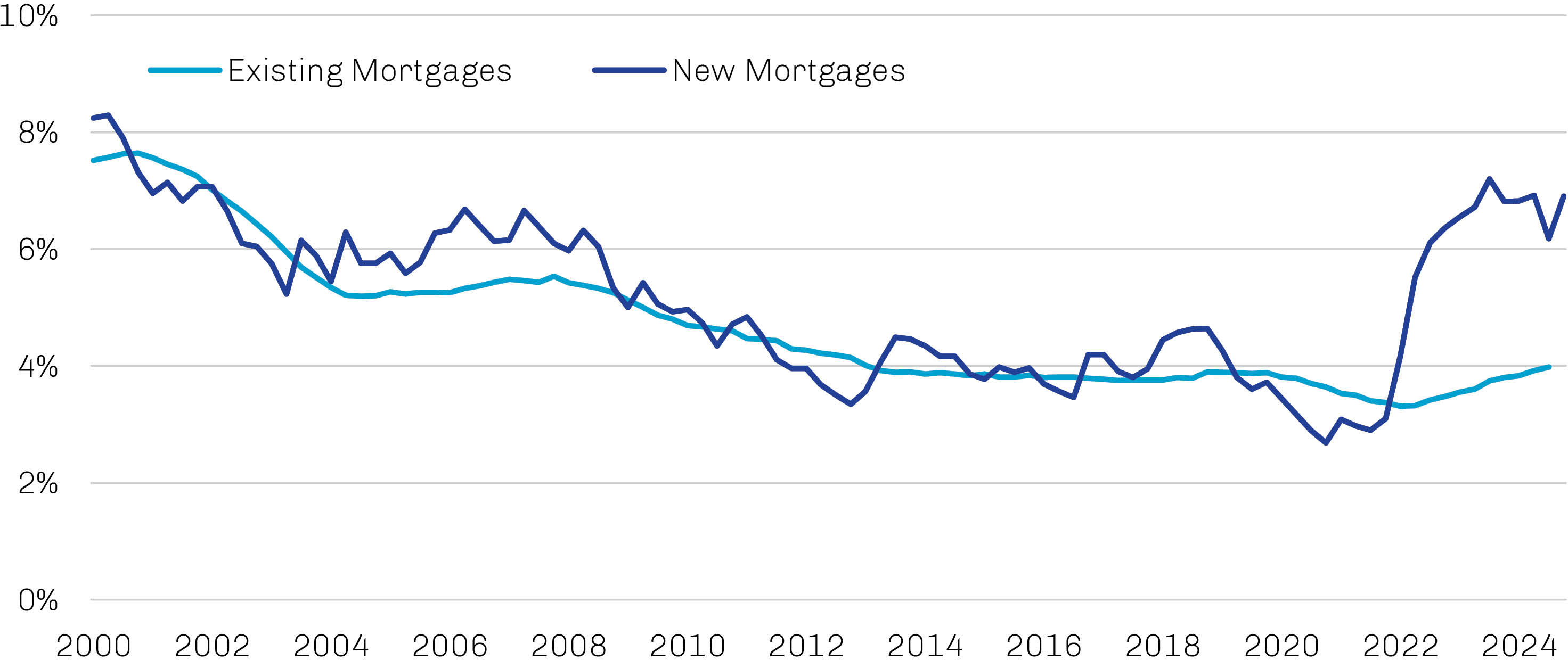
Source: Morgan Stanley Research, National Association of Realtors, Freddie Mac, US Census Bureau, Bureau of Labor Statistics; data as of December 26, 2024. Reflects latest available data for each series.
Housing demand remains well supported by consumer fundamentals, which, together with a shortage in supply, have buoyed home prices. Household net worth stands at a record high, debt levels remain manageable even off Covid-19-era lows, and indicators of consumer confidence have been biased higher.3 This is evidenced in Exhibit 3 by Fannie Mae’s Home Purchase Sentiment Index, which has reclaimed levels consistent with pre-tightening trends as consumers acclimate to the environment of higher home prices and higher mortgage rates.
Exhibit 3. Consumer Housing Sentiment Has Rebounded from All-Time Lows
Fannie Mae Home Purchase Sentiment Index, December 2019 through December 2024
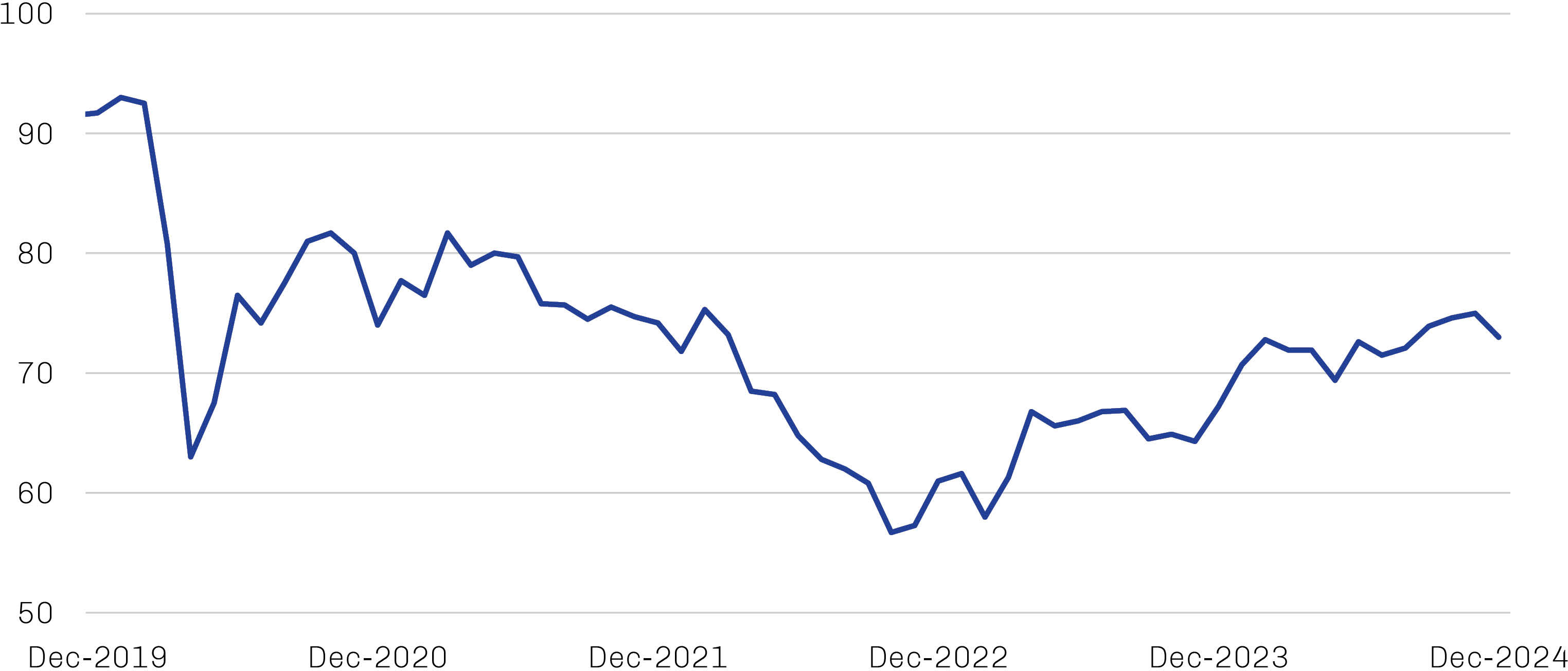
Source: Fannie Mae; data as of January 7, 2025.
Such acclimation may continue to be necessary. Mortgage rates have been on the rise since the Federal Reserve began cutting its policy rate in September, contrary to what many observers may have expected. This is because mortgage rates are based on long-term Treasury yields, which in turn are impacted by expectations for future short-term interest rates rather than their current levels. Due in large part to persistent inflation, expectations for future rates have been biased higher, pulling long Treasury and mortgage rates along with them.
But while improved affordability could drive additional demand, supply is likely to remain the US housing market’s main problem.
Credit Risk Premia in Public Markets Has Shrunk...
The strong performance of credit over the last 18 months has driven spreads for most public securities markets well below their long-term averages. This is particularly true of traditional public fixed income products, which enter 2025 facing the most severe valuation constraints seen in more than two decades, as shown in Exhibit 4.
Exhibit 4. Valuations Are Constrained Across Many Public Credit Segments
Spread Percentile Ranks, January 2010 through December 2024
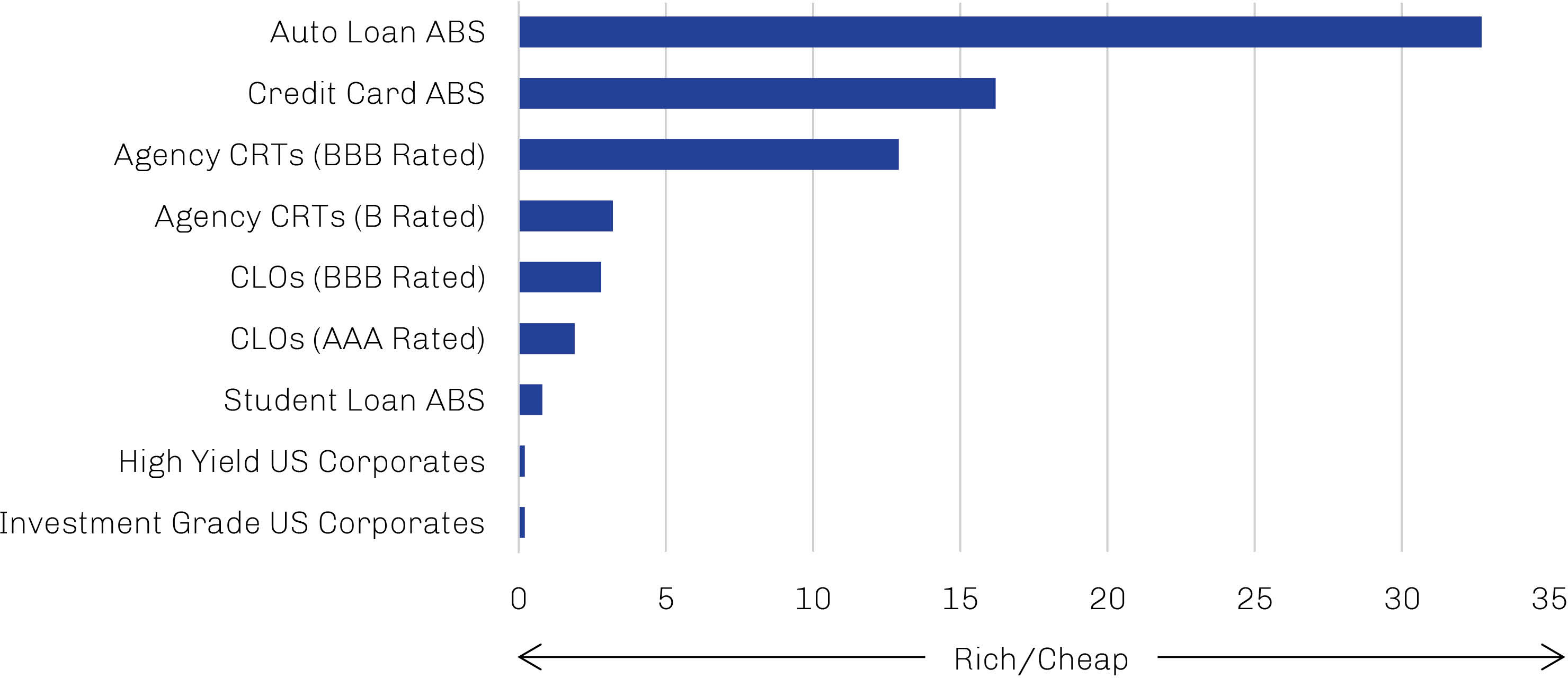
Note: Auto Loan ABS = ICE BofA AA-BBB US Fixed Rate Automobile ABS Index; Credit Card ABS = ICE BofA AA-BBB US Floating Rate Credit Card ABS Index; Agency CRTs (BBB Rated) and Agency CRTs (B Rated) = Goldman Sachs Global Investment Research calculations using outstanding prices; CLOs (BBB Rated) = Palmer Square CLO BBB Index; CLOs (AAA Rated) = Palmer Square CLO AAA Index; Student Loan ABS = ICE BofA AA-BBB US Floating Rate Student Loan ABS Index; High Yield US Corporates = Bloomberg US Corporate High Yield Index; Investment Grade US Corporates = Bloomberg US Corporate Index.
Source: PitchBook | LCD, Goldman Sachs Global Investment Research; data as of December 3, 2024. Index definitions can be found on the last page.
There are a range of real estate-backed structured credit products that trade publicly. In addition to the spread pressures felt across the fixed income complex, many of these products have been further squeezed by the “technical” bid for absolute yield as well as the resilient macro backdrop for US residential real estate. Credit risk transfer (CRT) securities—non-guaranteed mortgage-backed securities issued by US government sponsored enterprises Fannie Mae and Freddie Mac—are one such example.
CRTs have been particularly successful of late. CRTs pay a fixed spread over 30-day SOFR (Secured Overnight Financing Rate), which is highly sensitive to changes in the federal funds rate and rose from near zero to well above 5% during the Fed’s 2022–23 hiking cycle.4 At the same time, CRT spreads to SOFR widened significantly on concerns that central bank tightening would trigger a recession and an associated increase in mortgage delinquencies. As a result of higher rates and wider spreads, these securities offered very high yields despite containing attractive structural provisions; through the Covid-19 dislocation, for example, no CRT transaction experienced a loss greater than two basis points.5 With the US economy proving resilient despite tighter financial conditions, risk appetites soon returned and CRT spreads have tightened by about 1,000 basis points since late 2022, as shown in Exhibit 5. This tightening provided CRT investors with robust returns, but we believe the entry point for these vehicles appears less attractive at current levels.
Exhibit 5. Credit Risk Transfer Spreads Have Tightened Meaningfully Over the Past Two Years
CRT B2 Spread to 30-Day SOFR in Basis Points, December 2020 through December 2024
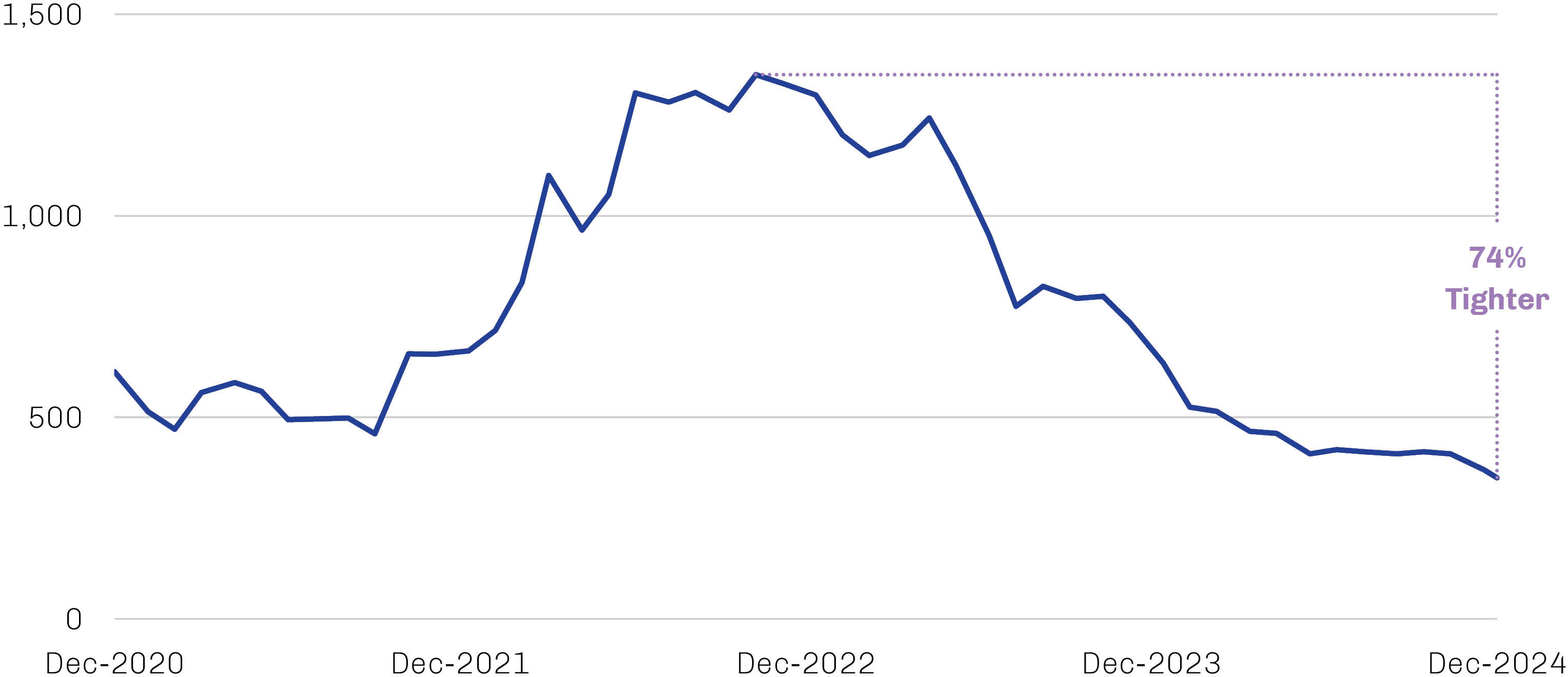
Source: Citi Research; data as of December 13, 2024.
...but We Believe Opportunities in Private Residential Real Estate Debt Remain Attractive
With public credit spreads near all-time tights entering 2025, the returns on residential mortgage securities like CRTs are likely to be more modest in the months ahead.6 At this time, we believe there are more attractive opportunities to be found on the private side of the real estate debt market, including residential transitional loans and land banking. Private markets tend to have a delayed and lagged response to changes in lending costs, and their structural complexity and illiquidity typically provide an additional boost to yields. Further, the short durations and robust cash flows typical of these assets enable the frequent reinvestment of proceeds, providing investors optionality to migrate into public credit opportunities should market conditions shift.
While high home prices and strong demand would seem to be powerful motivators for homebuilders to aggressively fill the housing gap, significant headwinds persist. Notably, rising construction costs have weighed on builders’ profit margins and put further upward pressure on home prices. Materials, equipment and labor costs are all up sharply post-Covid, and the price of land has outstripped the rise in housing prices nationally.7 The explicit and/or implicit costs of regulatory compliance in order to develop buildable lots—which include a range of requirements from zoning approval to permitting to environmental studies—have remained high as well; a study from 2021 found that regulations imposed by all levels of government account for nearly 24% of the final price of a new single-family home.8
Given high costs and lengthy timelines, homebuilders have long relied heavily on credit to finance new construction or the renovation of existing properties for resale. But commercial banks, their traditional source of funding, have pulled back from certain types of real estate activities—including acquisition, development and construction lending—due to regulatory changes enacted in the wake of the global financial crisis. As shown in Exhibit 6, construction loans as a percentage of bank total assets today are less than half of what they were in 2007.
Exhibit 6. Traditional Banks Have Pulled Back from Certain Types of Real Estate Lending
Construction Loans as a Percentage of Total Bank Assets, 2007 through 2024
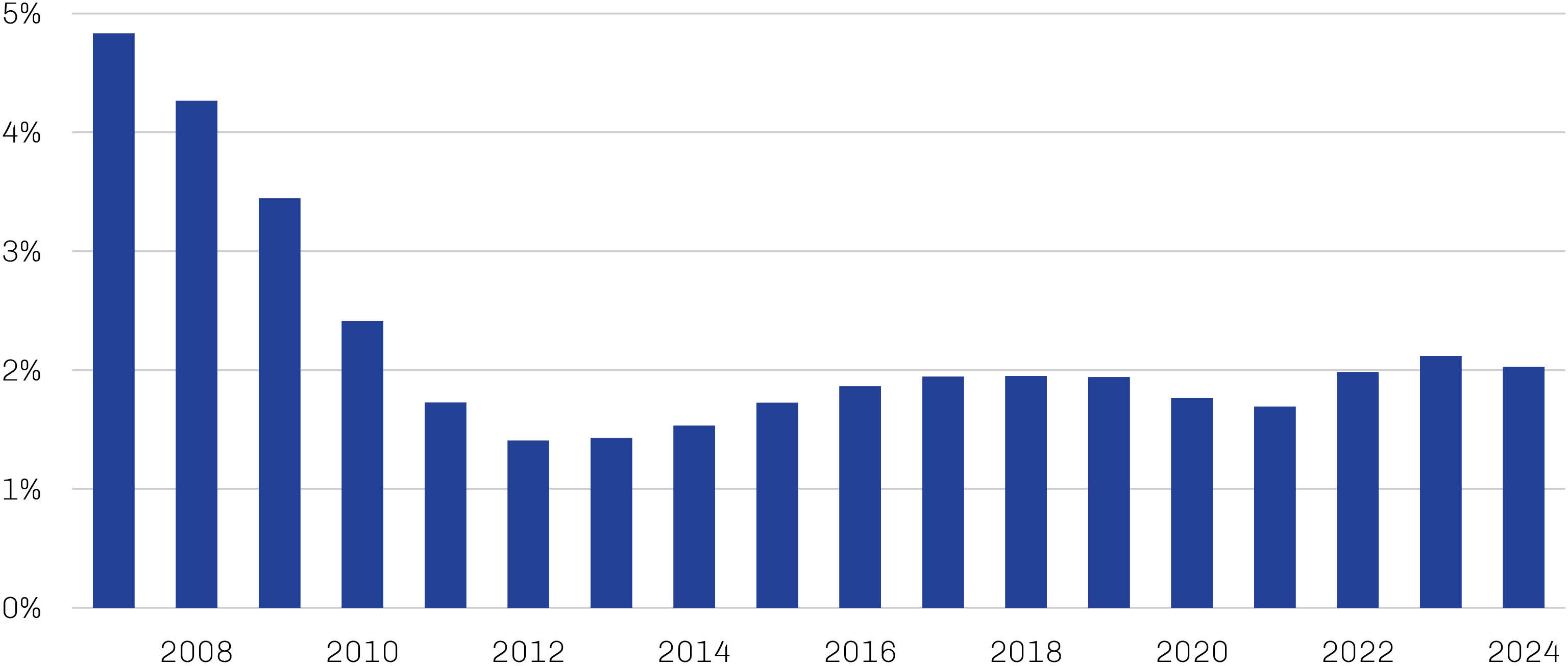
Source: Federal Deposit Insurance Corporation; data as of December 31, 2024.
As commercial bank activity has receded, a fragmented collection of specialty lenders have stepped in. The majority of these lenders lack the capital to underwrite and hold these loans at meaningful scale, however, which has presented an opportunity for asset managers to provide necessary liquidity to the real estate industry at attractive terms.
Residential transitional loans are an example of one such opportunity. To many buyers, a refurbished home in an established neighborhood with proven infrastructure like schools, parks and retail is more desirable than a new home in a new area. As could be inferred from the aged state of the US housing stock depicted in Exhibit 7, not every legacy property is in turnkey condition, which has fueled the proliferation of “fix and flip” activity. Real estate developers purchase single-family residences with the intent of renovating and reselling them at a profit within a short period of time. There is a similar dynamic evident in the multifamily space, as existing rental properties are upgraded to standards that can command higher rents.
Exhibit 7. Aged US Housing Stock Fuels Demand for Renovation Capital
Estimates of Median Age in Years of US Owner-Occupied Housing, 2005 through 2022
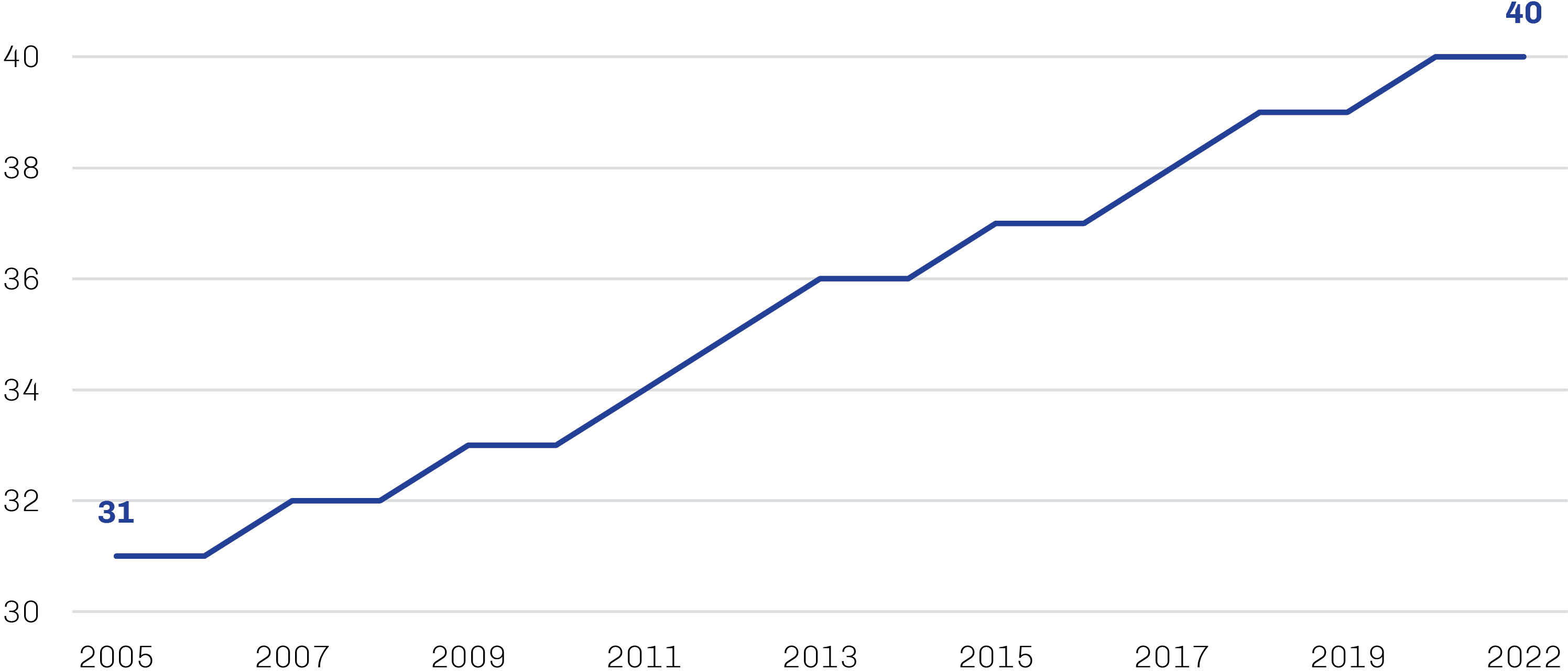
Note: The Census Bureau did not release the standard American Community Survey in 2020 due to data-collection disruptions experienced during the Covid-19 pandemic.
Source: US Census Bureau, American Community Survey; data as of December 31, 2022. Reflects latest data available.
Residential transitional loans provide the capital for these rehabs. These loans are typically 12 to 18 months in tenor and secured by a first lien on the property, with interest-only payments until the principal is due at maturity. Frequently, these loans are originated by small, regional private lenders focused exclusively on this type of financing and related services. Lacking the scale to hold these loans to maturity, originators often sell them to large, nonbank asset managers looking to build diversified portfolios of residential transitional loans they believe will generate compelling risk-adjusted long-term returns.
Land banking is another area where we see opportunity. The limited supply of buildable land is among the factors constraining the rebound in US new-home construction, a fact often overlooked in a country with a land area in excess of 3.5 million square miles.9 Beyond the limitations of local zoning laws, the process of preparing raw land for construction—from design to infrastructure build—often takes two years or more as a result of significant local, state and national regulations.10
This lag can be a challenge for homebuilders trying to maintain robust development pipelines without compromising liquidity and financial flexibility, and many have moved toward “land-light” business models in response. As such, off-balance-sheet financing solutions like land banking—in which a capital provider, in exchange for a fee, acquires and holds property on behalf of a builder that has agreed to purchase lots on the property at a predetermined schedule—have become a staple of builders’ land inventory-management strategies. Large public homebuilders, in particular, have demonstrated a willingness to pay a significant premium to the prevailing interest rate on corporate debt for the benefits of such an arrangement.
Staying Nimble Within a Secular Growth Story
While dynamics remain supportive of the US housing market as a whole, we believe current return prospects favor private lending opportunities. However, history has shown that public markets can quickly grow volatile, especially in an environment of tight credit spreads; it would not be surprising to see spreads widen significantly should some sort of near-term dislocation occur. We believe investors able to nimbly adjust their public and private exposures and seize upon unique opportunities as they emerge may be well positioned for success in the residential real estate debt space.
1. Source: Freddie Mac, National Mortgage Database; data as of December 31, 2024.
2. Source: Freddie Mac; data as of December 19, 2024.
3. Source: Federal Reserve Board of St. Louis; data as of September 30, 2024.
4. Source: Federal Reserve Bank of St. Louis; data as of August 31, 2024.
5. Source: Fannie Mae, Freddie Mac and Napier Park; data as of December 31, 2024.
6. Source: ICE Data Indices; data as of January 9, 2025.
7. Source: Federal Housing Finance Agency; data as of August 6, 2024.
8. Source: National Association of Home Builders; data as of May 5, 2021.
9. Source: US Census Bureau; data as of December 31, 2024.
10. Source: National Association of Home Builders; data as of May 5, 2021.
The opinions expressed are not necessarily those of the firm. These materials are provided for informational purposes only. These opinions are not intended to be a forecast of future events, a guarantee of future results, or investment advice. Any statistics contained herein have been obtained from sources believed to be reliable, but the accuracy of this information cannot be guaranteed. The views expressed herein may change at any time subsequent to the date of issue hereof. The information provided is not to be construed as a recommendation to buy, hold or sell or the solicitation or an offer to buy or sell any fund or security.
Past performance is not indicative of future results.
Risk Disclosures
All investments involve the risk of loss of principal.
There are risks associated with investing in securities of foreign countries, such as erratic market conditions, economic and political instability and fluctuations in currency exchange rates.
Diversification does not guarantee investment returns and does not eliminate the risk of loss.
Alternative Investment Risks
Alternative investments can be speculative and are not suitable for all investors. Investing in alternative investments is only intended for experienced and sophisticated investors who are willing and able to bear the high economic risks associated with such an investment. Investors should carefully review and consider potential risks before investing. Certain of these risks include:
• Loss of all or a substantial portion of the investment;
• Lack of liquidity in that there may be no secondary market or interest in the strategy and none is expected to develop;
• Volatility of returns;
• Interest rate risk;
• Restrictions on transferring interests in a private investment strategy;
• Potential lack of diversification and resulting higher risk due to concentration within one of more sectors, industries, countries or regions;
• Absence of information regarding valuations and pricing;
• Complex tax structures and delays in tax reporting;
• Less regulation and higher fees than mutual funds;
• Use of leverage, which magnifies the potential for gain or loss on amounts invested and is generally considered a speculative investment technique and increases the risks associated with investing in the strategy;
• Carried interest, which may cause the strategy to make more speculative, higher risk investments than would be the case in absence of such arrangements; and
• Below-investment-grade loans, which may default and adversely affect returns
Definitions
AA credit rating—as used by S&P Global Ratings and Fitch Ratings—is an investment grade rating on a bond considered to have a very strong capacity to meet its financial commitments. The equivalent rating from Moody’s Investors Service is Aa.
AAA credit rating—as used by S&P Global Ratings and Fitch Ratings—is an investment grade rating on a bond considered to have an extremely strong capacity to meet its financial commitments. The equivalent rating from Moody’s Investors Service is Aaa.
BBB credit rating—as used by S&P Global Ratings and Fitch Ratings—is an investment grade rating on a bond considered to have adequate capacity to meet its financial
commitments but that is more susceptible to adverse business, financial and economic conditions. The equivalent rating from Moody’s Investors Service is Baa.
Collateralized loan obligations (CLO) are financial instruments collateralized by a pool of corporate loans.
A credit rating is an assessment provided by a nationally recognized statistical rating organization (NRSRO) of the creditworthiness of an issuer with respect to debt
obligations, including specific securities, money market instruments or other bonds. Ratings are measured on a scale that generally ranges from AAA/Aaa (highest) to D/RD (lowest); ratings are subject to change without notice. Not rated (NR) indicates that the debtor was not rated and should not be interpreted as indicating low quality.
Credit-risk transfer (CRT) securities are synthetic securitizations that reference the credit risk of a designated group of mortgage loans guaranteed by Fannie Mae or
Freddie Mac.
Government-sponsored enterprises (GSEs) were established and chartered by the US federal government for public policy purposes. They are private companies, and
their securities are not backed by the full faith and credit of the federal government.
Mortgage-backed securities (MBS) are debt securities whose payments of principal and interest are backed by the cash flow generated by pools of mortgage loans.
Secured Overnight Financing Rate (SOFR) is a broad measure of the cost of borrowing cash overnight collateralized by Treasury securities.
Bloomberg US Corporate Bond Index (Gross/Total) measures the performance of investment grade, fixed-rate, taxable corporate bond market. It includes US dollar
denominated securities publicly issued by US and non-US industrial, utility and financial issuers. A total-return index tracks price changes and reinvestment of distribution income.
Bloomberg US Corporate High Yield Bond Index (Gross/Total) measures the US dollar-denominated, high yield, fixed-rate corporate bond market. Securities are classified as high yield if the middle rating of Moody’s, Fitch and S&P is Ba1/BB+/BB+ or below. A total-return index tracks price changes and reinvestment of distribution income.
Fannie Mae Home Purchase Sentiment Index (HPSI) (Gross/Total) distills consumer responses to Fannie Mae’s monthly National Housing Survey into a single indicator
designed to provide signals on future housing outcomes. A total-return index tracks price changes and reinvestment of distribution income.
ICE BofA AA-BBB US Fixed Rate Automobile ABS Index (Gross/Total) measures the performance of asset-backed securities collateralized by automobile loans with a
middle rating in a range of AA/Aa to BBB/Baa as measured Moody’s, Fitch and S&P. A total-return index tracks price changes and reinvestment of distribution income.
ICE BofA AA-BBB US Floating Rate Credit Card ABS Index (Gross/Total) measures the performance of asset-backed securities collateralized by credit card loans with a
middle rating in a range of AA/Aa to BBB/Baa as measured Moody’s, Fitch and S&P. A total-return index tracks price changes and reinvestment of distribution income.
ICE BofA AA-BBB US Floating Rate Student Loan ABS Index (Gross/Total) measures the performance of asset-backed securities collateralized by student loans with a
middle rating in a range of AA/Aa to BBB/Baa as measured Moody’s, Fitch and S&P. A total-return index tracks price changes and reinvestment of distribution income.
Palmer Square CLO AAA Index (Gross/Total) is a subindex of the Palmer Square CLO Debt Index that tracks only CLOs originally rated AAA. A total-return index tracks
price changes and reinvestment of distribution income.
Palmer Square CLO BBB Index (Gross/Total) is a subindex of the Palmer Square CLO Debt Index that tracks only CLOs originally rated BBB. A total-return index tracks
price changes and reinvestment of distribution income.
Important Information for Non-US Residents
This material and the information contained herein is provided for informational purposes only, do not constitute and is not intended to constitute an offer of securities,
and accordingly should not be construed as such. Any funds or other products or services referenced in this material may not be licensed in all jurisdictions and unless
otherwise indicated, no regulator or government authority has reviewed this material or the merits of the products and services referenced herein. This material and the
information contained herein has been made available in accordance with the restrictions and/or limitations implemented by any applicable laws and regulations. This
material is directed at and intended for institutional investors (as such term is defined in any applicable jurisdiction). This material is provided on a confidential basis for
informational purposes only and may not be reproduced in any form. This material is for general information only and is not intended as investment advice or any other
specific recommendation as to any particular course of action or inaction. The information in this material does not take into account the specific investment objectives,
financial situation, tax situation or particular needs of the recipient. Before acting on any information in this material, prospective investors should inform themselves of
and observe all applicable laws, rules and regulations of any relevant jurisdictions and obtain independent advice if required. This material is for the use of the named
addressee only and should not be given, forwarded or shown to any other person (other than employees, agents or consultants in connection with the addressee’s consideration thereof).
Important Information for Residents in the Abu Dhabi Global Market (ADGM)
This material constitutes an Exempt Communication or is not otherwise subject to the financial promotion restriction in accordance with the Financial Services and
Markets Regulation of the ADGM. It must not be delivered to, or relied on by, any other person. The ADGM does not accept any responsibility for the content of the information included in this material, including the accuracy or completeness of such information. The ADGM has also not assessed the suitability of the products or services to which this material relates to any particular investor or type of investor. If you do not understand the contents of this material or are unsure whether the products or services to which this material relates are suitable for your individual investment objectives and circumstances, you should consult an authorised financial adviser.
Important Information for Residents of Australia
This communication is exclusively directed and intended for wholesale clients (as such term is defined in Australian Corporations Act 2001 (Cth) only and, by receiving
it, each prospective investor is deemed to represent and warrant that it is a wholesale client. The information contained herein is provided for informational purposes
only and should not be considered a solicitation or offering of investment services, nor a solicitation to sell or buy any shares of any securities (nor shall any such
securities be offered or sold to any person) in any jurisdiction where such solicitation or offering would be unlawful under the applicable laws of such jurisdiction. Unless
otherwise indicated, no regulator or government authority has reviewed this material or the merits of the products and services referenced herein. This material and the
information contained herein has been made available in accordance with the restrictions and/or limitations implemented by any applicable laws and regulations. This
material is provided on a confidential basis for informational purposes only and may not be reproduced in any form. Before acting on any information in this material,
prospective investors should inform themselves of and observe all applicable laws, rules and regulations of any relevant jurisdictions and obtain independent advice if
required. This material should not be relied upon as investment advice and is not a recommendation to adopt any investment strategy. This material is for the use of the
named addressee only and should not be given, forwarded or shown to any other person (other than employees, agents or consultants in connection with the addressee’s consideration thereof). First Eagle Investment Management, LLC is exempt from the requirement to hold an Australian financial services licence under the Corporations Act 2001 (Cth) in respect of the financial services it provides to wholesale clients in Australia and is regulated by the US Securities and Exchange Commission under US laws, which differ from Australian laws.
Important Information for Residents of Brazil
First Eagle Investment Management, LLC is not accredited with the Brazilian Securities Commission - CVM to perform investment management services. The investment
management services may not be publicly offered or sold to the public in Brazil. Documents relating to the investment management services as well as the information
contained therein may not be supplied to the public in Brazil.
Important Information for Residents of Canada
This material does not constitute investment advice or an offer or solicitation to sell or a solicitation of an offer to buy any product or service or any securities (nor
shall any product or service or any securities be offered or sold to any person until such time as such offer and sale is permitted under applicable securities laws.) Any
products or services or any securities referenced in this material may not be licensed in all jurisdictions, and unless otherwise indicated, no securities commission or
similar authority in Canada has reviewed this material or the merits of the products and services referenced herein. If you receive a copy of this material, you should
note that there may be restrictions or limitations to whom these materials may be made available. This material is private and confidential and is directed at and intended for institutional investors and is only being provided to “permitted clients” as defined under the Canadian Securities Administrators’ National Instrument 31-103 – Registration Requirements, Exemptions and Ongoing Registrant Obligations. This material is for informational purposes only. This material does not constitute investment advice and should not be relied upon as such. Before acting on any information in this material, prospective clients should inform themselves of and observe all applicable laws and regulations of Canada. Prospective clients should inform themselves as to the legal requirements and tax consequences within the countries of their citizenship, residence, domicile and place of business with respect to the acquisition, holding or disposal of shares or the ongoing provision of services, and any foreign exchange restrictions that may be relevant thereto. First Eagle Investment Management, LLC is not authorized to provide investment advice and/or management money in Canada.
Important Information for Residents of Dubai
This material and the information contained herein is provided for informational purposes only, does not constitute and is not intended to constitute an offer of securities, and accordingly should not be construed as such. Any funds or other products or services referenced in this material may not be licensed in all jurisdictions and unless otherwise indicated, no regulator or government authority has reviewed this document or the merits of the products and services referenced herein. This material and the information contained herein has been made available in accordance with the restrictions and/or limitations implemented by any applicable laws and regulations. This material is directed at and intended for institutional investors (as such term is defined in any applicable jurisdiction). This material is provided on a confidential basis for informational purposes only and may not be reproduced in any form. Before acting on any information in this material, prospective investors should inform themselves of and observe all applicable laws, rules and regulations of any relevant jurisdictions and obtain independent advice if required. This material is for the use of the named addressee only and should not be given, forwarded or shown to any other person (other than employees, agents or consultants in connection with the addressee’s consideration thereof).
Important Information for Residents of the State of Kuwait
The Capital Markets Authority and all other Regulatory Bodies in Kuwait assume no responsibility whatsoever for the contents of this material and do not approve the
contents thereof or verify their validity and accuracy. The Capital Markets Authority and all other Regulatory Bodies in Kuwait assume no responsibility whatsoever for
any damages that may result from relying on the contents of this material either wholly or partially. It is recommended to seek the advice of an investment advisor.
Important Information for Residents of the State of Qatar
Any funds, products or services referenced in this material may not be licensed in all jurisdictions, including the State of Qatar (“Qatar”), and unless otherwise indicated,
no regulator or government authority, including the Qatar Financial Markets Authority (QFMA), has reviewed this material or the merits of the products and services
referenced herein. If you receive a copy of this material, you may not treat this as constituting an offer, and you should note that there may be restrictions or limitations as to whom these materials may be made available. This material is directed at and intended for a limited number of “qualified” investors (as such term is defined under the laws of Qatar). This material is provided on a confidential basis for informational purposes only and may not be reproduced in any form. Before acting on any information in this material, prospective clients should inform themselves of and observe all applicable laws and regulations of any relevant jurisdictions, including any laws of Qatar. This material is for the use of the named addressee only and should not be given, forwarded or shown to any other person (other than employees, agents or consultants in connection with the addressee’s consideration thereof). Any entity responsible for forwarding this material to other parties takes responsibility for ensuring compliance with applicable securities laws.
Indexes are unmanaged and one cannot invest directly in an index.
FEF Distributors, LLC (“FEFD”) (SIPC), a limited purpose broker-dealer, distributes certain First Eagle products. FEFD does not provide services to any investor but rather
provides services to its First Eagle affiliates. As such, when FEFD presents a fund, strategy or other product to a prospective investor, FEFD and its representatives do not
determine whether an investment in the fund, strategy or other product is in the best interests of, or is otherwise beneficial or suitable for, the investor. No statement by
FEFD should be construed as a recommendation. Investors should exercise their own judgment and/or consult with a financial professional to determine whether it is
advisable for the investor to invest in any First Eagle fund, strategy or product.
First Eagle Investments is the brand name for First Eagle Investment Management, LLC and its subsidiary investment advisers. First Eagle Alternative Credit and Napier
Park are brand names for the two subsidiary investment advisers engaged in the alternative credit business.
©2025 First Eagle Investments. All rights reserved.